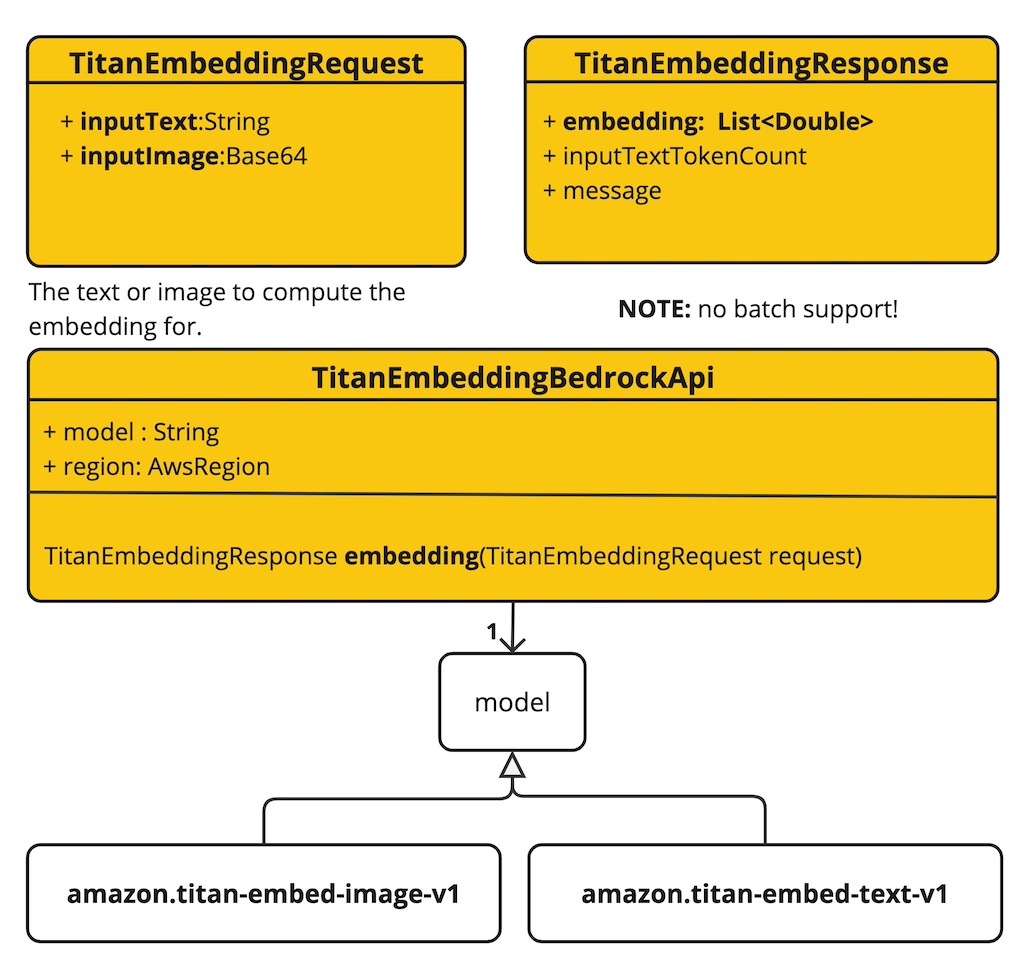Titan Embeddings
Provides Bedrock Titan Embedding model. Amazon Titan foundation models (FMs) provide customers with a breadth of high-performing image, multimodal embeddings, and text model choices, via a fully managed API. Amazon Titan models are created by AWS and pretrained on large datasets, making them powerful, general-purpose models built to support a variety of use cases, while also supporting the responsible use of AI. Use them as is or privately customize them with your own data.
| Bedrock Titan Embedding supports Text and Image embedding. |
| Bedrock Titan Embedding does NOT support batch embedding. |
The AWS Bedrock Titan Model Page and Amazon Bedrock User Guide contains detailed information on how to use the AWS hosted model.
Prerequisites
Refer to the Spring AI documentation on Amazon Bedrock for setting up API access.
Add Repositories and BOM
Spring AI artifacts are published in Maven Central and Spring Snapshot repositories. Refer to the Artifact Repositories section to add these repositories to your build system.
To help with dependency management, Spring AI provides a BOM (bill of materials) to ensure that a consistent version of Spring AI is used throughout the entire project. Refer to the Dependency Management section to add the Spring AI BOM to your build system.
Auto-configuration
|
There has been a significant change in the Spring AI auto-configuration, starter modules' artifact names. Please refer to the upgrade notes for more information. |
Add the spring-ai-starter-model-bedrock dependency to your project’s Maven pom.xml file:
<dependency>
<groupId>org.springframework.ai</groupId>
<artifactId>spring-ai-starter-model-bedrock</artifactId>
</dependency>or to your Gradle build.gradle build file.
dependencies {
implementation 'org.springframework.ai:spring-ai-starter-model-bedrock'
}| Refer to the Dependency Management section to add the Spring AI BOM to your build file. |
Enable Titan Embedding Support
By default, the Titan embedding model is disabled.
To enable it, set the spring.ai.model.embedding property to bedrock-titan in your application configuration:
spring.ai.model.embedding=bedrock-titanAlternatively, you can use Spring Expression Language (SpEL) to reference an environment variable:
# In application.yml
spring:
ai:
model:
embedding: ${AI_MODEL_EMBEDDING}# In your environment or .env file
export AI_MODEL_EMBEDDING=bedrock-titanYou can also set this property using Java system properties when starting your application:
java -Dspring.ai.model.embedding=bedrock-titan -jar your-application.jarEmbedding Properties
The prefix spring.ai.bedrock.aws is the property prefix to configure the connection to AWS Bedrock.
| Property | Description | Default |
|---|---|---|
spring.ai.bedrock.aws.region |
AWS region to use. |
us-east-1 |
spring.ai.bedrock.aws.access-key |
AWS access key. |
- |
spring.ai.bedrock.aws.secret-key |
AWS secret key. |
- |
|
Enabling and disabling of the embedding auto-configurations are now configured via top level properties with the prefix To enable, spring.ai.model.embedding=bedrock-titan (It is enabled by default) To disable, spring.ai.model.embedding=none (or any value which doesn’t match bedrock-titan) This change is done to allow configuration of multiple models. |
The prefix spring.ai.bedrock.titan.embedding (defined in BedrockTitanEmbeddingProperties) is the property prefix that configures the embedding model implementation for Titan.
Property |
Description |
Default |
spring.ai.bedrock.titan.embedding.enabled (Removed and no longer valid) |
Enable or disable support for Titan embedding |
false |
spring.ai.model.embedding |
Enable or disable support for Titan embedding |
bedrock-titan |
spring.ai.bedrock.titan.embedding.model |
The model id to use. See the |
amazon.titan-embed-image-v1 |
Supported values are: amazon.titan-embed-image-v1, amazon.titan-embed-text-v1 and amazon.titan-embed-text-v2:0.
Model ID values can also be found in the AWS Bedrock documentation for base model IDs.
Runtime Options
The BedrockTitanEmbeddingOptions.java provides model configurations, such as input-type.
On start-up, the default options can be configured with the BedrockTitanEmbeddingOptions.builder().inputType(type).build() method or the spring.ai.bedrock.titan.embedding.input-type properties.
At run-time you can override the default options by adding new, request specific, options to the EmbeddingRequest call.
For example to override the default temperature for a specific request:
EmbeddingResponse embeddingResponse = embeddingModel.call(
new EmbeddingRequest(List.of("Hello World", "World is big and salvation is near"),
BedrockTitanEmbeddingOptions.builder()
.inputType(InputType.TEXT)
.build()));Sample Controller
Create a new Spring Boot project and add the spring-ai-starter-model-bedrock to your pom (or gradle) dependencies.
Add a application.properties file, under the src/main/resources directory, to enable and configure the Titan Embedding model:
spring.ai.bedrock.aws.region=eu-central-1
spring.ai.bedrock.aws.access-key=${AWS_ACCESS_KEY_ID}
spring.ai.bedrock.aws.secret-key=${AWS_SECRET_ACCESS_KEY}
spring.ai.model.embedding=bedrock-titan
replace the regions, access-key and secret-key with your AWS credentials.
|
This will create a EmbeddingController implementation that you can inject into your class.
Here is an example of a simple @Controller class that uses the chat model for text generations.
@RestController
public class EmbeddingController {
private final EmbeddingModel embeddingModel;
@Autowired
public EmbeddingController(EmbeddingModel embeddingModel) {
this.embeddingModel = embeddingModel;
}
@GetMapping("/ai/embedding")
public Map embed(@RequestParam(value = "message", defaultValue = "Tell me a joke") String message) {
EmbeddingResponse embeddingResponse = this.embeddingModel.embedForResponse(List.of(message));
return Map.of("embedding", embeddingResponse);
}
}Manual Configuration
The BedrockTitanEmbeddingModel implements the EmbeddingModel and uses the Low-level TitanEmbeddingBedrockApi Client to connect to the Bedrock Titan service.
Add the spring-ai-bedrock dependency to your project’s Maven pom.xml file:
<dependency>
<groupId>org.springframework.ai</groupId>
<artifactId>spring-ai-bedrock</artifactId>
</dependency>or to your Gradle build.gradle build file.
dependencies {
implementation 'org.springframework.ai:spring-ai-bedrock'
}| Refer to the Dependency Management section to add the Spring AI BOM to your build file. |
Next, create an BedrockTitanEmbeddingModel and use it for text embeddings:
var titanEmbeddingApi = new TitanEmbeddingBedrockApi(
TitanEmbeddingModel.TITAN_EMBED_IMAGE_V1.id(), Region.US_EAST_1.id());
var embeddingModel = new BedrockTitanEmbeddingModel(this.titanEmbeddingApi);
EmbeddingResponse embeddingResponse = this.embeddingModel
.embedForResponse(List.of("Hello World")); // NOTE titan does not support batch embedding.Low-level TitanEmbeddingBedrockApi Client
The TitanEmbeddingBedrockApi provides is lightweight Java client on top of AWS Bedrock Titan Embedding models.
Following class diagram illustrates the TitanEmbeddingBedrockApi interface and building blocks:

The TitanEmbeddingBedrockApi supports the amazon.titan-embed-image-v1 and amazon.titan-embed-image-v1 models for single and batch embedding computation.
Here is a simple snippet how to use the api programmatically:
TitanEmbeddingBedrockApi titanEmbedApi = new TitanEmbeddingBedrockApi(
TitanEmbeddingModel.TITAN_EMBED_TEXT_V1.id(), Region.US_EAST_1.id());
TitanEmbeddingRequest request = TitanEmbeddingRequest.builder()
.withInputText("I like to eat apples.")
.build();
TitanEmbeddingResponse response = this.titanEmbedApi.embedding(this.request);To embed an image you need to convert it into base64 format:
TitanEmbeddingBedrockApi titanEmbedApi = new TitanEmbeddingBedrockApi(
TitanEmbeddingModel.TITAN_EMBED_IMAGE_V1.id(), Region.US_EAST_1.id());
byte[] image = new DefaultResourceLoader()
.getResource("classpath:/spring_framework.png")
.getContentAsByteArray();
TitanEmbeddingRequest request = TitanEmbeddingRequest.builder()
.withInputImage(Base64.getEncoder().encodeToString(this.image))
.build();
TitanEmbeddingResponse response = this.titanEmbedApi.embedding(this.request);
